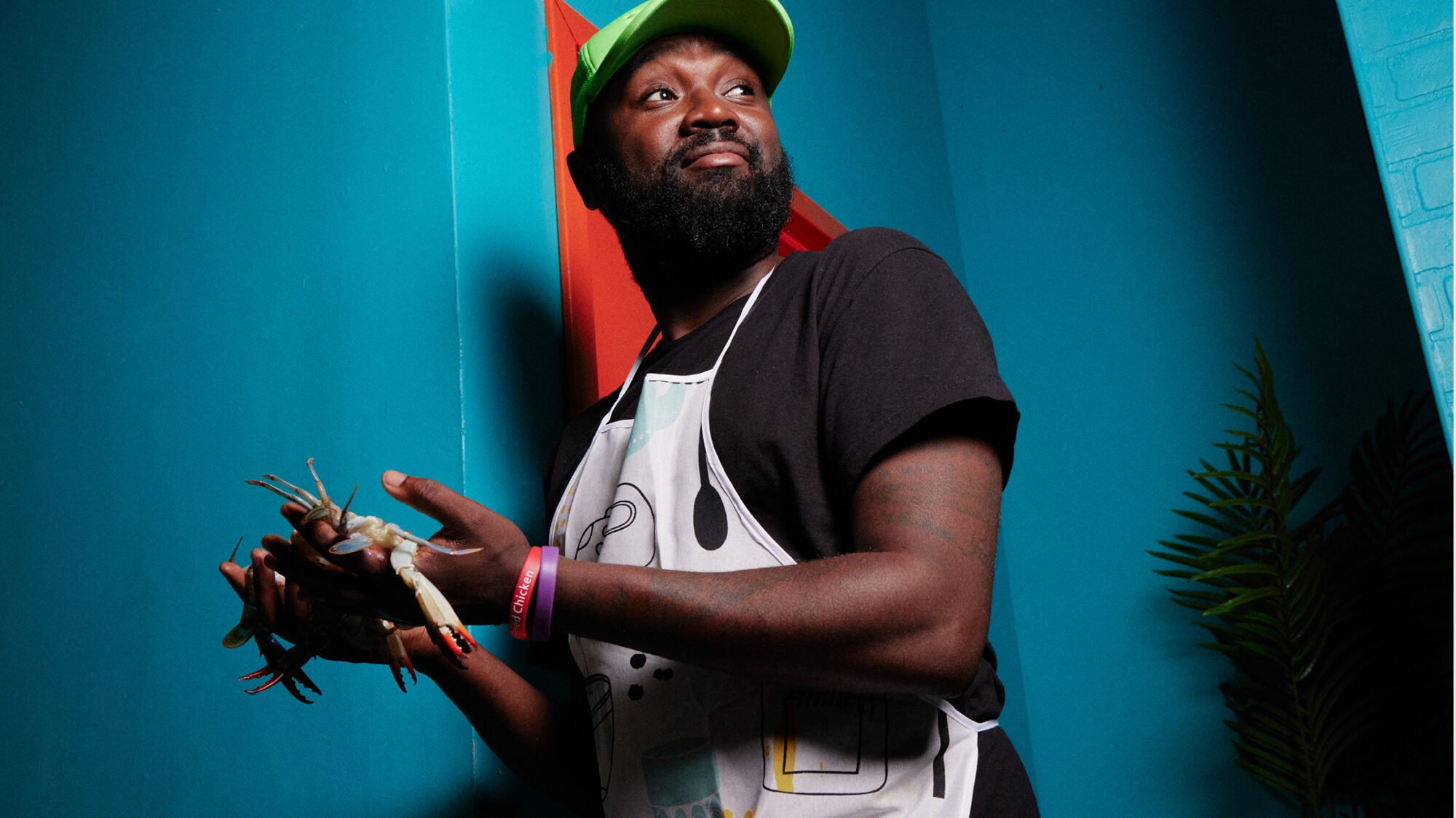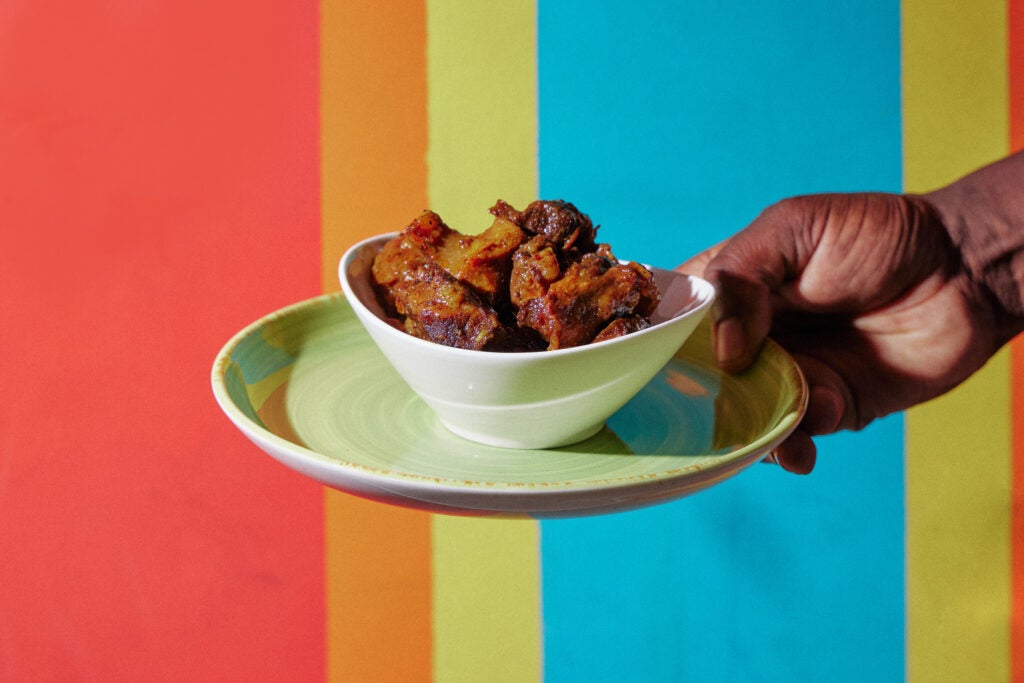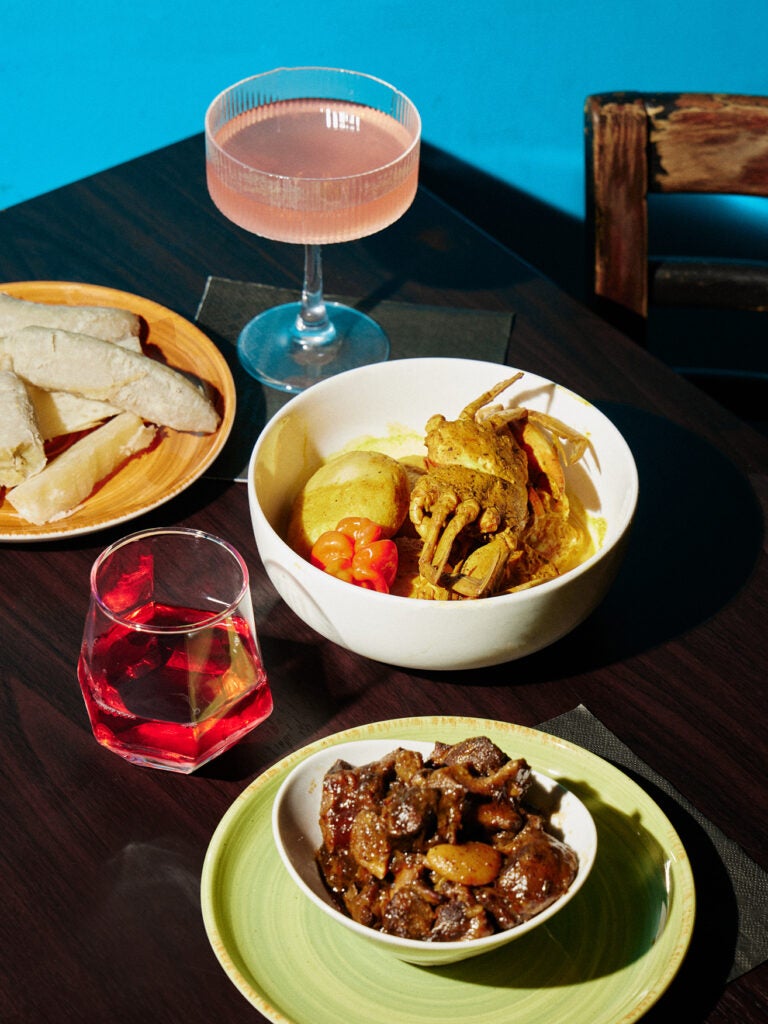
Osei Blackett, aka Chef Picky, isn’t afraid to shake up culinary tradition.
“It took a long time and a lot of money to educate the public about sushi, to convince Americans to eat raw fish, right? I don’t want it to take that long to educate people on Trinidadian dishes. That’s what made me start to experiment, to find the sweet spot that brings Caribbean flavors and American dishes together.”
I’m talking to Trinidadian chef Osei Blackett, known to his many online and offline followers as “Chef Picky,” about straddling identities, culinary modernism and honoring traditions, the cost of assimilation and the load-bearing pillars of cultures in conversation with one another. We’re discussing the Caribbean American dream. But the entry point is doubles, a miracle of a working-class lunch that was allegedly invented in the 1930s and likely immigrated to the United States from Trinidad and Tobago, along with many Caribbeans in the ‘60s, following President Lyndon B. Johnson’s Immigration and Nationality Act that sought to peel back the racist quota system that had dictated 20th-century US immigration policy up to that point.
Doubles are composed of two turmeric-tinted disks of bara, or puri (unleavened fried Indian flatbread), best described as a delightfully chewy hybrid of crepe and chalupa, layered with channa (or channa masala), a mash of curried chickpea stew, and *ideally* doused with (hot) pepper sauce and/or an array of sweet chutneys. In Trinidad, that would be it, but controversially, among doubles’ most dogmatic disciples, at least in Brooklyn roti spots, there’s also the option of having the channa topped with a standard selection of ubiquitous Caribbean steam table proteins: curry goat, braised oxtail, stew chicken, curry chicken, curry shrimp, and curry beef. The doubles is then swaddled in wax paper, rolled in tin foil and stuffed in a brown bag sleeve. If the place is any good, your nesting doll of wrapped lunch in its plastic handled takeout bag will be soaked with grease and sauce by the time you unwrap it all to quickly devour at home.
The doubles wants—it aches—to be a handheld foodstuff. But in Flatbush, Brooklyn, if you order your doubles with a protein, it’s going to be served bone-in. Slivers of braised oxtail are attached to star-shaped chunks of tailbone. Broken shards of chicken femur extend from stewed thigh meat. Flecks of goat shoulder bone poke out of the meat like seeds from a watermelon. With a few minor tweaks, as Chef Picky suggests, a doubles is a taco-like, craveable snack that a crafty restaurant group could build a global franchise around. But at virtually every doubles joint, the bones remain.
Blackett explains that it’s a pragmatic decision made by the restaurant and dictated by the market. “Eating doubles with meat is not traditional,” he says. “If you’re putting boneless meat onto a doubles, you’re going to have to put on way more so it looks right, or the people are going to complain. They’ll also complain if you raise the prices. Trinidadian people don’t want to pay for things ‘outside’ that they think they could cook. You can charge them an arm and a leg for pasta or food they think is fine dining. But if you’re making a Trinidadian dish, it can’t be expensive.”

I began a parasocial relationship with Chef Picky’s food several years ago through some amalgam of the algorithm and his restaurant popping up in friends’ IG stories. I love lamb, which is a protein you don’t often see on Caribbean takeout menus, but it featured prominently in his posts. So, one hungover morning, I hopped in a dollar van with a friend and rode down to a spread-out, sleepy stretch of Flatbush Avenue closer to the ocean than the river, between Farragut and Foster. The storefront I walked into that early afternoon resembled many of the excellent takeout restaurants you can find up and down this heavily Caribbean corridor in South Brooklyn, with perhaps slightly more considered and professional branding. The color scheme was lemon and lime, and it was brightly lit and tiled, with very little seating, while two mounted flat-screen TVs behind the counter played sports on a pirated feed or Soca videos off YouTube.
The food that’s “indigenous” to Trinidad and Tobago is one of the world’s great fusion cuisines. It is, of course, the confluence of a familiar litany of colonialism’s racial and economic atrocities, but the resulting product coming from the two islands that make up the country colloquially known as “TnT,” the southernmost island nation in the Caribbean, is a stunningly harmonious quilt of Taíno, African, Indian, Chinese, European, Latin American, and Arab food cultures. There are Sino-Trini restaurants, a stoner’s wet dream that allows the diner to top their fried rice or lo mein with jerk pork. At any local roti spot in Flatbush, you can get an aloo pie, basically a knish with a Caribbean soul. But even in the context of the amorphous cultural boundaries of Trini cuisine, Chef Blackett is presenting something novel.
I ordered a lamb gyro with perfectly seasoned precooked and flash frozen fries, and split an order of pineapple jerk wings with my friend. The lamb was a chunk of shoulder chop dunked (rather than brushed, in the traditional Trini barbecue style) in a barbecue sauce with culantro and ginger-spiked Caribbean accents that turned to lacquer on the grill, rolled in a pita with crisp shrettuce and a few cubes of tomato. The lamb and fries were served with small plastic ramekins of garlic mint sauce, pineapple pepper sauce, and mango ketchup, a perfect melding of halal street cart and Caribbean takeout. It was so obvious, so congruous, and so delicious that I couldn’t believe I had never seen anyone combine the two prior to this random hole-in-the-wall bordering Midwood. We quickly laid waste to our plates as well as the wings. I took a dollar van home in a stuffed fog and slept through the rest of the day.
In 2004, at age 20, Osei Blackett came to New York from San Fernando, or Sando, the biggest city in his native Trinidad. Blackett tried majoring in business administration at Borough of Manhattan Community College before picking up a flier and pursuing his childhood passion with a few cooking classes at Kingsborough Community College, then promptly transferring to complete a degree in tourism and hospitality. He followed this with a paid internship in the kitchen at Negril Village in Manhattan, then worked as a custodian at the James Beard Foundation, which was located in a townhouse in Greenwich Village at the time.
But he always kept a “safe job.” While working for Verizon, Blackett opened the first iteration of Picky Eaters (“Picky” is a nonsensical nickname that dates so far back to the island that Blackett can’t remember where it comes from) on Nostrand Avenue below Empire Avenue in 2010, long before the neighborhood was branded “Little Caribbean.” He opened a second location in Flatbush several years later, which also closed, but Blackett is still working his various local pop-ups and globe spanning food events, as well as out of his home base, Ariapita.
For much of its history, the progress of Caribbean cuisine in New York has been slow and stubborn, resistant to change, insistent on literal interpretations of its scripture. When it comes to the menu, authenticity and accuracy, however you may define those ideas—as they relate to dishes whose recipes can change from town to town or even from house to house on a Caribbean island—are paramount for the many fiercely proud people who miss the culture and food they moved away from.
Many of the routinely excellent Caribbean takeout restaurants you’ll find across the city staunchly reject the tenets of European-born restaurant philosophy and hospitality codified equally by culinary schools, whiners on Yelp, and Danny Meyer. The item you want the most (and sometimes, somehow, the majority of the menu) may not be available just yet, and the service may not be attentive or particularly enthused to be taking your order. There is a calculus in Flatbush that we have all accepted which dictates that bad service equals good food. Caribbean restaurants and Caribbean food move on their own time, which may explain why they’ve been able to stay largely preserved and unexploited thus far.
For much of its history, the progress of Caribbean cuisine in New York has been slow and stubborn, resistant to change, insistent on literal interpretations of its scripture.
Blackett’s food and philosophy are harbingers of change, but if you’re looking around the city, there are more signs of transformation than ever. In 2024, you can find jerk chicken wedged into a banh mi or served in a taco at a hipster cocktail castle, $9 artisanal beef patties appear at open-air food malls, and traces of curry goat and pepper sauce are served in Lincoln Center at Kwame Onwuachi’s fine-dining mecca Tatiana. But back when I first discovered Picky Eaters, and even to this day, it was a rare thing for a Caribbean-born chef, cooking affordable weeknight offerings in a remote corridor in South Brooklyn for a majority-Caribbean-diaspora clientele, to be so bold and experimental in their offerings.
Perhaps this authenticity in his menu writing and cooking explains why Blackett is no longer a niche taste among Flatbush locals. With playful, food-curious events like On D Pavement (launched this year), which incorporates chefs from all over the world pulling up in his corner of Flatbush for his take on the tradition Caribbean “lime,” and sticky pop-up concepts like his playful chicken wing stand and Everything Oxtail, Chef Picky has found room at the forefront of a conversation taking place among a young cohort of Caribbean chefs testing the boundaries of Caribbean food and spreading its gospel around the country. When I caught up with Blackett, he was in the middle of a brief respite in Brooklyn between food events at the Olympics in Paris and an annual food festival back home in TnT.
He was recently quoted in the New York Times on the rising hype around and accompanying cost of oxtail, he contributed a recipe for my beloved Trini-style BBQ lamb to Food & Wine, and he counts the nationally renowned chefs Tavel Bristol-Joseph (of Guyana) in Austin, Texas; Gregory Gourdet (of Haitian descent) in Portland, Oregon; and Kwame Onwuachi (Half Trini who grew up in the Bronx and has Nigerian and Trini ancestry) in New York among his friends and collaborators.
I asked Blackett what his success means to him. He told me, “I don’t really look at where I came from, honestly. I should probably do that more. But being able to start this conversation as a Trinidadian chef, there’s nothing better than seeing food that you literally grew up on, where only an island of one million people knew about it…featured in international publications like Food & Wine. It’s amazing.”
One of the chefs who has made an appearance at On D Pavement is Jase Franklyn, a 39-year-old high school track-and-field coach at Brooklyn Poly Prep who, since 2017, has pursued his passion as a pitmaster, selling plates of food around New York every weekend at Smorgasburg and other festivals. Jase is from Tobago, which he calls the “mellower” of the two islands that make up TnT. The two chefs and neighbors at Smorgasburg quickly bonded and forged a friendship around their desire to push boundaries. Jase grew up barbecuing in Tobago with his mother, and he favors using direct heat with the coals placed several feet from his protein to achieve low-and-slow perfection. Jase describes chicken, ribs, and fish as the foundations of TnT barbecue. His art is applying Trinibagonian flavor profiles to American proteins like brisket, cooked with something closer to American technique.
The distinction in Jase’s barbecue can be found in his wet green rub, made from the Trinidad pimento pepper or “flavor pepper,” and the array of fruit-based barbecue sauces he serves alongside his dishes, spiked with mango, passionfruit, and tamarind. “In America, pitmasters say the meat speaks for itself. If you have to put sauce on it, that means it wasn’t good. In our country, it’s completely different. It has nothing to do with the meat being bad. We just put sauce on everything,” Jase says.

It is hard to know precisely what an equitable future for Caribbean cuisine looks like, but it has to include Picky, Jase, and other chefs of the Caribbean diaspora like them, who are doing the work in stalls, on trucks, and in takeout spots in entrenched neighborhoods like Flatbush, educating and innovating with affordable food served in clamshells and paper boats that retains the inspiration of its source material.
The question facing Blackett and other Caribbean chefs of his cohort is how to cross the Rubicon—how to honor their restless desire for honest self-expression and experimentation, how to translate the brilliant, delicious cuisine served in takeout kitchens in the Caribbean neighborhoods of New York’s outer boroughs to a wider audience without watering it down. They can’t. It means too much to the Caribbean Brooklynites who came before them, who had to literally fight to preserve their culture in high school cafeterias and locker rooms from E-Hall (Erasmus Hall) to Grady.
I asked Chef Picky if he sees any downside to the recent proliferation and cross-pollination happening in Caribbean cuisine. “Everyone knows Jamaican food—jerk, curry, oxtail—now. If you see an elevated cousin of jerk chicken, you understand what the chef is doing, right? But they’re going easy on the Scotch bonnet. They’re not smoking the chicken with allspice wood. They will get jerk sauce and just pour it over. So that’s my fear. It’s in the back of my head. I don’t like to think about it.”
An example of the push-pull between the progressive culinary spirit and traditionalist taste could be found in the conflict Blackett ran into when rolling out his crab and dumplings dish at his restaurant Ariapita, a more formal sit-down restaurant and rum bar that focuses on the beloved “B-sides” of the Trinidadian kitchen rather than the comfortable, recognizable pop hits. The restaurant, located on Flatbush just north of the Nostrand Junction, doubles as a bully pulpit and a laboratory for Blackett. A Trini classic, crab and dumplings is commonly served on the island as halved blue crabs in a green curry gravy studded with flour-and-water dumplings. It’s delicious, but the crabs can make for difficult, messy eating, with the scant, tender meat trapped in hard shells coated in a muddy curry.
Blackett addressed this problem by serving his iteration of the dish with soft shell crabs (when in season), another pragmatic innovation that sounds obvious and only to the benefit of the diner, but the chef received some pushback for messing with a classic. Blackett sympathized with his diners’ initial skepticism. “It’s memories, right? You’re going to the river, you get this crab, and you’re scrubbing it, and you’re cooking it, and you’re sitting down, and you’re chewing the bones and sucking [the meat] out. It’s a niche for us Caribbean people. I always go for authenticity over convenience, but I also try to find a middle ground, so if a Trinidadian comes, they understand what I’m doing. But if someone has never been to Trinidad but wanted to try our food, they also understand.”